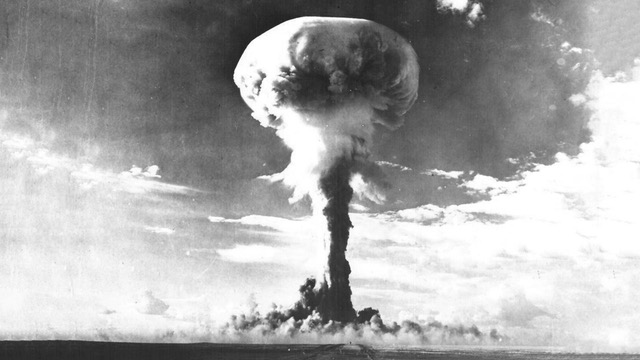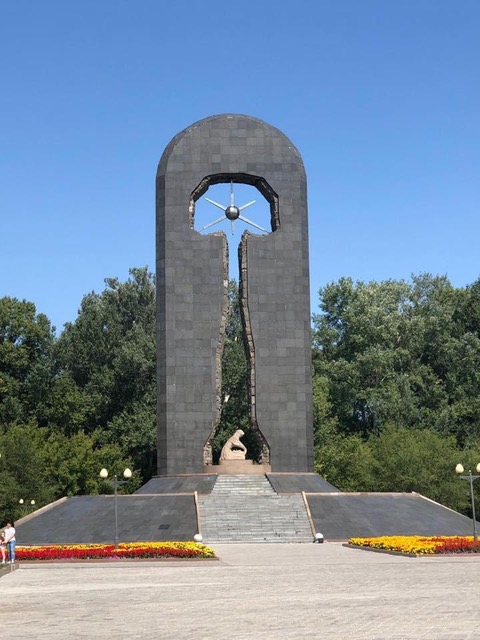Nuclear tests: Legacy of destruction, source of ambition
Marked by a horrible past, Kazakhstan is devoted to a world without nuclear tests and nuclear weapons. Today, on the International Day Against Nuclear Tests — a day established by the United Nations on the initiative of Kazakhstan — the Ambassador of Kazakhstan in Belgium, Mrs. Aigul Kuspan, takes stock of her country’s efforts in this regard and expresses her profound hope for the future.
Semipalatinsk (current Semey), a region in the northeastern steppe of Kazakhstan, was selected by the Soviet Union in 1947 as the main test location for its nuclear weapons program. The first test took place in 1949, with the fall-out spreading to nearby villages and settlements. Seventy years later, nuclear tests are still taking place elsewhere in the world and the global arsenal is estimated at more than 15,000 nuclear weapons. However, the legacy of nuclear testing and nuclear weapons is nothing but destruction and human suffering.
Between 1949 and 1989, a total of around 456 nuclear tests took place at the Semipalatinsk test site with a total force of around 2600 times the atomic bomb on Hiroshima. The consequences were so disastrous for the local population and the region (more than one million people were exposed to radioactivity with all the horrific consequences) that Kazakhstan, led by First President Nursultan Nazarbayev, voluntarily renounced its nuclear arsenal following the implosion of the Soviet Union and is actively committed to a nuclear-free world until today.

Thanks to the efforts of First President Nursultan Nazarbayev, Kazakhstan has rapidly gone from the possessor of the fourth in the world in its destructive power nuclear arsenal to the leading country in the field of nuclear disarmament and non-proliferation. Under his leadership, from the day of independence, our country has been persistently striving to achieve the goal of a nuclear-free world, as well as to turn it into the main task of the mankind in the 21st century.
It is in this context, as Ambassador of Kazakhstan to Belgium, that I am addressing you today. After all, today is the International Day Against Nuclear Tests. The memorial day was set up in 2009 via a UN resolution at the initiative of Kazakhstan to commemorate the closure of the Semipalatinsk nuclear test site on 29 August 1991. The purpose of the memorial day is two-fold. Not only do we attempt to raise general awareness of the adverse effects of nuclear testing and do we emphasize the need for a stop to nuclear testing as a means of achieving a nuclear-free world. Today we also reflect on the human suffering as we commemorate the victims of nuclear tests, wherever they were conducted.
In an era of geopolitical upheavals and rising international tensions, the fight for a world free of nuclear weapons has become even more important. My country is firmly convinced that a general and complete nuclear disarmament and the abolition of nuclear tests are essential conditions for a safer world.

To this end, we created a real nuclear-free zone with our neighboring countries, under the so-called Semipalatinsk treaty. This means that Kazakhstan, Kyrgyzstan, Tajikistan, Turkmenistan and Uzbekistan have agreed not to produce, acquire, test or possess nuclear weapons. In addition, in cooperation with the International Atomic Energy Agency, my country set up the Low Enriched Uranium Bank with the aim of safely supplying the world with low-enriched uranium which is used to produce fuel for civilian purposes. Furthermore, Kazakhstan contributed to the adoption of The Joint Comprehensive Plan of Action on the Iran’s nuclear program by providing that country with natural uranium for civilian energy use.
Other countries possessing nuclear test sites followed the example of Kazakhstan and ceased functioning of their nuclear test sites, which, in turn, paved the way for the adoption in 1996 of the Comprehensive Nuclear Test Ban Treaty (CTBT). Kazakhstan is actively committed to the entry into force of the CTBT which prohibits all nuclear explosions in any environment, both for military and civilian purposes. To date, 184 countries have signed the treaty, but it has unfortunately not entered into force because certain countries (with considerable nuclear capabilities) have not yet ratified the treaty.
In 2012, during the international conference “From the Prohibition of Nuclear Tests – to a World Free of Nuclear Weapons”, held on August 29, 2012 in Nur-Sultan, an initiative to establish The ATOM Project (Abolish Testing. Our Mission) was announced by the First President Nursultan Nazarbayev.
The ATOM Project is an international campaign designed to inform the international community about the dangers and consequences of nuclear weapons tests both for the environment and, above all, for humanity.The goal of this project is to achieve real, permanent change by uniting global communities in the fight to finally eradicate nuclear weapons testing and, ultimately, to free the world from nuclear weapons.
Within the framework of the Project, anyone who opposes nuclear weapons can sign an online petition to governments around the world urging them to permanently abandon nuclear tests, achieve the early entry into force of the Comprehensive Test Ban Treaty, and thus take an important step towards building a world free from nuclear threats.
Goodwill, courageous initiatives, voluntary moratoria and a strong international consensus against nuclear testing – however important – do not outweigh a globally legally binding ban on nuclear testing.
The test location of Semipalatinsk is a scar from a previous trauma. It is a trauma that we Kazakhs will never forget. But it is a scar that continues to inspire us to work with our friends on a future without nuclear tests, and ultimately a world without nuclear weapons.



